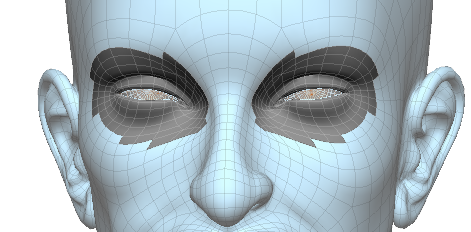Sculpting the deformers is one of the main ways to get the face to look the way you want it, especially for extreme or unusual expressions that often require tweaking. Using sculpting, you can adjust the eyelids and the soft area under the eyes, which is deformed by the orbicularis oculi (eye ring muscle), and other muscles that contract tissue in the lower half of the face. They contribute to facial expressions and can indicate aggression and separate a fake smile from a genuine smile.
This section describes how to sculpt the eyelid deformers, but for general information on sculpting, including symmetry issues and the sculpt history, see Overview of Sculpting.
To sculpt the eyelid deformers
On the face in the viewport, select an animation control in the eye region and position it where you want it in relation to the sculpting you will be doing.
In the Sculpt area at the bottom of the Tune panel, click the Eyelid button.

Face Robot generates a special eye mesh that lets you sculpt separately from the actual face mesh. An outline of this special sculpt mesh becomes translucent and blends with the rest of the face.

Move the points on the sculpt mesh as you like to adjust the eye area's geometry. You can use any modeling tool, but these are some that you'll find useful:
Use the Relax tool on some of the polygons (choose Model  Modify
Modify  Deform
Deform  Relax on the main menu bar).
Relax on the main menu bar).
The Tweak Component tool - tag the points (press T) and press M, then and move points, edges, or polygons.
The proportional modeling tool - click the Prop button on the main command panel, then press M and move the points.
Weight painting tool - press W and paint values on a weight map (press Ctrl+W to open the paint brush properties). See Painting Weight Maps for tips on painting.
Click the Sculpt  Apply button when you're happy with the results of the sculpting. This bakes the changes you made to the sculpting mesh back to
the face's geometry.
Apply button when you're happy with the results of the sculpting. This bakes the changes you made to the sculpting mesh back to
the face's geometry.
The sculpt is saved as a pose shape that you can then mute, apply, or delete using the sculpt history — see Working with the Sculpt History for information.
When you're finished, click the Act button at the bottom of the Tune panel to go to the Act panel. On the Face > Select tab, click the Reset All button to return the animation controls to their default positions.
Now when you move the animation control to the position it was in when you started sculpting, you'll see the adjustments you made to the geometry.